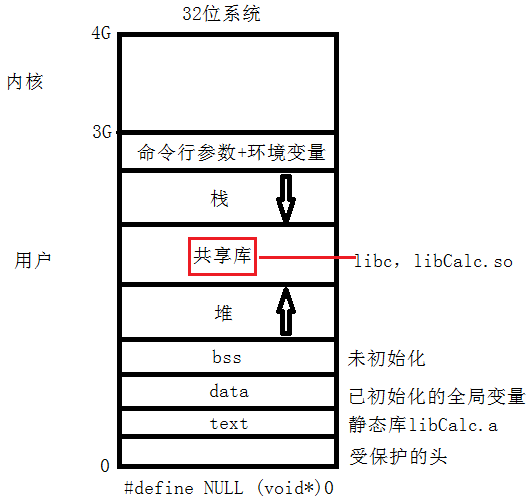一. GCC的使用
1. GCC的编译过程

(1)预处理(cpp)gcc -E(输出问价通常以 .i 结尾),将头文件展开,宏替换等操作;
(2)编译器(gcc)gcc -S(输出问价以 .s 结尾)生成汇编代码;
(3)汇编器(as)gcc -c(输出文件以 .o 结尾)将汇编编译成二进制文件;
(4)连接器(ld)gcc,链接 lib 库生成可执行文件。
执行过程如下(hello.c):
#include<stdio.h> int main() { printf("hello world\n"); return 0; }
Linux执行过程:
[root@centos1 src]# gcc -E hello.c >> hello.i [root@centos1 src]# gcc -S hello.i [root@centos1 src]# gcc -c hello.s [root@centos1 src]# gcc -o hello.out hello.o [root@centos1 src]# ./hello.out hello world
注:第4步如果使用 ld 会报如下错误
[root@centos1 src]# ld hello.o ld: warning: cannot find entry symbol _start; defaulting to 00000000004000b0 hello.o: In function `main': hello.c:(.text+0xa): undefined reference to `puts'
没有 __start 是因为C程序以main为主函数,汇编以start为主函数入口,改用gcc连接就可以,如果非用ld,需要自己链接libc.so库。
2. GCC编译参数
- -I 包含头文件路径(可以使绝对路径,也可以是相对路径)
- -O 优化选项,1-3越高优先级越高
- -L 包含的库路径
- -l(L的小写)指定库名(通常libxxx.so或者libxxx.a,-lxxx)
- -o 目标文件
- -c 编译成.o文件
- -g 用于gdb调试不加此选项不能gdb调试
- -Wall 显示更多的警告
- -D 指定宏编译
- -lstdc++ 编译c++代码
二. 动静库
1. 制作库文件作用
作用:将实现某部分功能的代码封装成库文件,以方便调用,或者是对代码进行保护加密。
应用场景:有时想将某代码提供给别人用,但是又不想公开源代码,这时可以将代码封装成库文件。在开发中调用其他人员编写的库。
2. 静态库
(1)制作步骤
1)编译.o文件
2)将.o文件打包:ar rcs libname.a file1.o file2.o file3.o ...
3)将头文件与库一起发布
文件内容及路径分布如下:
[root@centos1 calc]# tree
.
├── include
│ └── head.h
├── lib
├── main.c
└── src
├── add.c
└── sub.c

1 #include<stdio.h> 2 3 int add(int a, int b); 4 int sub(int a, int b);

1 #include "head.h" 2 3 int main(void) 4 { 5 int a = 10, b = 10; 6 7 printf("%d + %d is %d\n", a, b, add(a, b)); 8 printf("%d - %d is %d\n", a, b, sub(a, b)); 9 10 return 0; 11 }

1 #include "head.h" 2 3 int add(int a, int b) 4 { 5 return a + b; 6 }

1 #include "head.h" 2 3 int sub(int a, int b) 4 { 5 return a - b; 6 }
- 编译为.o文件
进入到 src 目录下执行:
[root@centos1 src]# gcc -c *.c -I ../include/ [root@centos1 src]# ll 总用量 16 -rw-r--r--. 1 root root 63 4月 20 14:53 add.c -rw-r--r--. 1 root root 1240 4月 20 15:10 add.o -rw-r--r--. 1 root root 63 4月 20 14:24 sub.c -rw-r--r--. 1 root root 1240 4月 20 15:10 sub.o
- 将.o文件打包,制作成libCalc.a静态库
[root@centos1 src]# ar rcs libCalc.a *.o [root@centos1 src]# ll 总用量 20 -rw-r--r--. 1 root root 63 4月 20 14:53 add.c -rw-r--r--. 1 root root 1240 4月 20 15:10 add.o -rw-r--r--. 1 root root 2688 4月 20 15:12 libCalc.a -rw-r--r--. 1 root root 63 4月 20 14:24 sub.c -rw-r--r--. 1 root root 1240 4月 20 15:10 sub.o
(2)使用
编译时需要加静态库名(记得路径),-I 包含头文件
- 使用静态库编译main.c并执行main
我们将libCalc.a移动到上层的lib中并退回到calc目录,编译main.c并执行:
[root@centos1 calc]# gcc main.c -o main -I include/ -L ./lib -lCalc [root@centos1 calc]# ll 总用量 24 drwxr-xr-x. 2 root root 4096 4月 20 15:07 include drwxr-xr-x. 2 root root 4096 4月 20 15:14 lib -rwxr-xr-x. 1 root root 6838 4月 20 15:14 main -rw-r--r--. 1 root root 179 4月 20 14:57 main.c drwxr-xr-x. 2 root root 4096 4月 20 15:14 src [root@centos1 calc]# ./main 10 + 10 is 20 10 - 10 is 0
可以用 nm 命令查看文件内容:
[root@centos1 calc]# nm lib/libCalc.a add.o: 0000000000000000 T add sub.o: 0000000000000000 T sub
(3)静态库优缺点
优点:
1)执行快
2)发布应用时不需要发布库
缺点:
1)执行程序体积会比较大
2)库变更时需要重新编译程序
三. 动态库
1. 制作步骤
(1)编译与位置无关的代码(下图共享库),生成.o目标文件,关键参数 -fPIC

(2)将.o文件打包,关键参数 -shared
(3)将库与头文件一起发布
- 生成.o目标文件
文件路径和内容同上,进入到src目录,生成.o目标文件:
[root@centos1 src]# gcc -fPIC -c *.c -I ../include/ [root@centos1 src]# ll 总用量 16 -rw-r--r--. 1 root root 63 4月 20 14:53 add.c -rw-r--r--. 1 root root 1240 4月 20 15:20 add.o -rw-r--r--. 1 root root 63 4月 20 14:24 sub.c -rw-r--r--. 1 root root 1240 4月 20 15:20 sub.o
- 将.o文件打包生成动态库
[root@centos1 src]# gcc -shared -o libCalc.so *.o [root@centos1 src]# ll 总用量 24 -rw-r--r--. 1 root root 63 4月 20 14:53 add.c -rw-r--r--. 1 root root 1240 4月 20 15:20 add.o -rwxr-xr-x. 1 root root 5817 4月 20 15:21 libCalc.so -rw-r--r--. 1 root root 63 4月 20 14:24 sub.c -rw-r--r--. 1 root root 1240 4月 20 15:20 sub.o
2. 使用
- 使用生成的动态库,-L 指定动态库路径 -l 指定库名(gcc main.c -o main -I include/ -L ./lib -lCalc)
退出到calc目录下,将动态库拷贝到lib目录下并编译mian.c并执行main:
[root@centos1 calc]# gcc main.c -o main -I include/ -L ./lib -lCalc [root@centos1 calc]# ll 总用量 24 drwxr-xr-x. 2 root root 4096 4月 20 15:07 include drwxr-xr-x. 2 root root 4096 4月 20 15:29 lib -rwxr-xr-x. 1 root root 7066 4月 20 15:30 main -rw-r--r--. 1 root root 179 4月 20 14:57 main.c drwxr-xr-x. 2 root root 4096 4月 20 15:29 src [root@centos1 calc]# ./main ./main: error while loading shared libraries: libCalc.so: cannot open shared object file: No such file or directory
无法找到动态库目标文件,解决方法有三个:
(1)拷贝到/lib下(不允许,容易与别人库命名重合)
(2)将库路径增加到环境变量LD_LIBRARY_PATH中(不是特别推荐)
[root@centos1 calc]# export LD_LIBRARY_PATH=/home/xuejiale/src/calc/lib/:$LD_LIBRARY_PATH [root@centos1 calc]# ./main 10 + 10 is 20 10 - 10 is 0
(3)配置/etc/ld.so.conf文件,增加 /home/xuejiale/src/calc/lib/ 路径,执行 ldconfig -v,并执行main
/home/xuejiale/src/calc/lib/
[root@centos1 calc]# ./main 10 + 10 is 20 10 - 10 is 0
3. 优缺点总结
缺点:
- 执行时需要加载动态库,相对而言,比静态库慢
- 发布应用时需要同步发布动态库
优点:
- 执行程序体积小
- 库变更时,一般不需要重新编译应用
动静态库总结:
静态库特点:
- 库的代码会编译进程序里面,所以静态库编译的程序比较大。
- 由静态库编译的程序不用依赖于系统的环境变量,所以环境变量有没有这个库文件,也可以运行。
动态库特点:
- 库的代码不会编译进程序里面,所以动态库编译的程序比较小。
- 由动态库编译的程序依赖于系统的环境变量有没有这个库文件,没有则运行不了。
